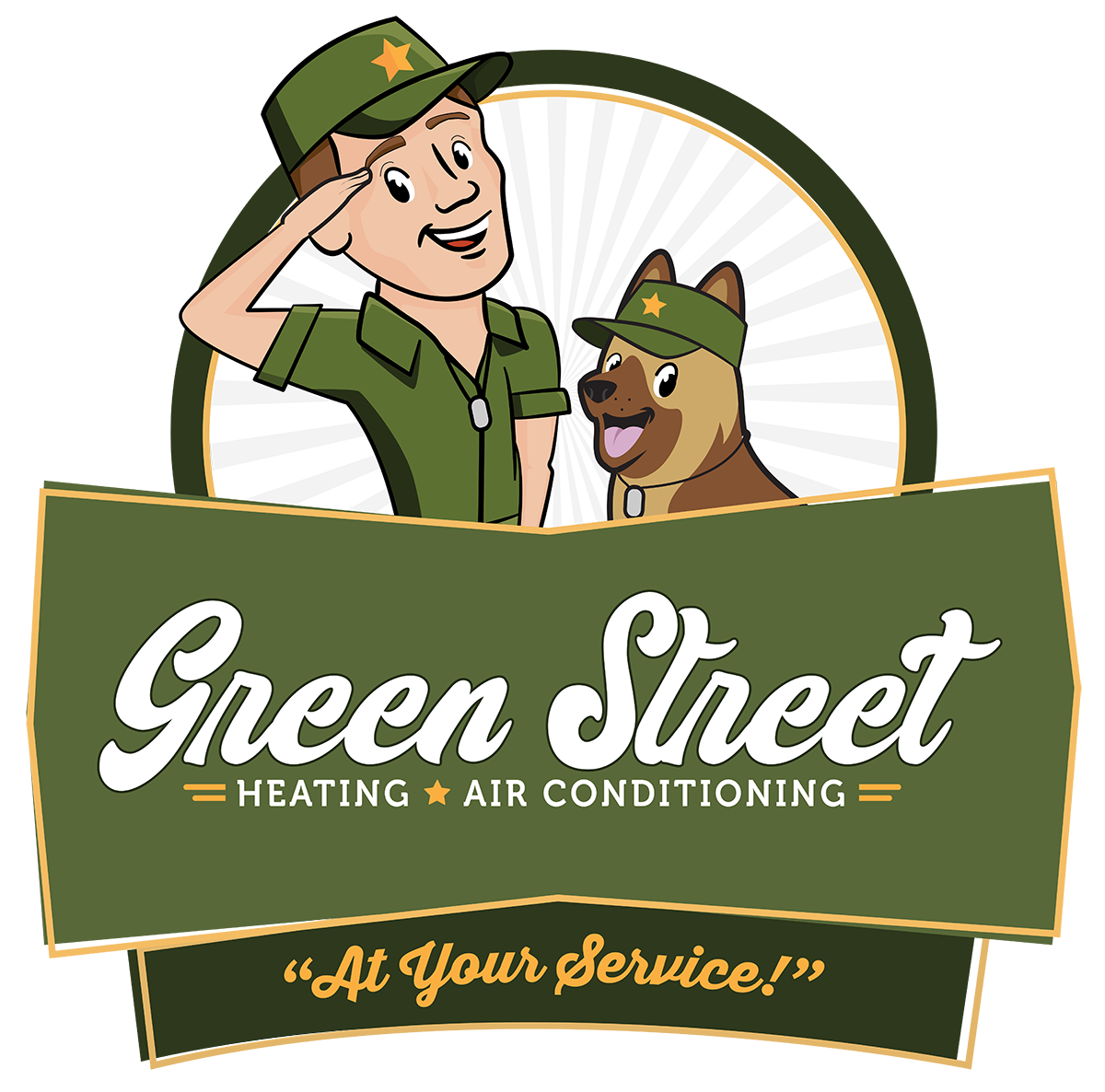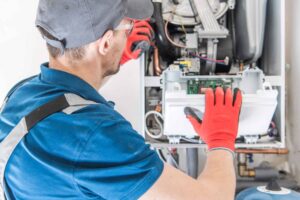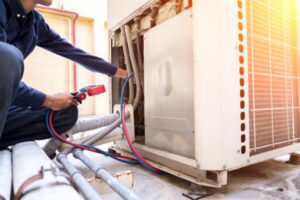If you’ve recently discovered a puddle of water on the floor around your furnace, you’re not alone. Many homeowners, especially in humid climates like Tennessee face this issue. While a small amount of condensation is normal in high-efficiency furnaces, excessive water leakage can indicate a problem that needs immediate attention. Let’s explore the common reasons why your furnace might be leaking water from the bottom, how to diagnose the issue, and what steps you can take to fix it.
Understanding How Furnaces Produce Condensation
Before diving into troubleshooting for furnace leaking water, it’s essential to understand why furnaces produce water in the first place.
How High-Efficiency Furnaces Work
Modern high-efficiency furnaces (90% AFUE or higher) extract more heat from combustion gases, which cools the exhaust to the point where water vapor condenses into liquid. This condensation is typically drained away through a condensate drain line.
Standard-Efficiency Furnaces & Water Leaks
Older furnaces (80% AFUE or lower) usually don’t produce condensation under normal conditions. If you notice water pooling around a standard furnace, it could indicate:
- A leaking humidifier attached to the system
- A crack in the heat exchanger (a serious issue requiring immediate attention)
- AC drainage problems (if the furnace and AC share a drain line)
For furnace efficiency tips from experts, visit our blog or call us now.
6 Common Causes of Furnace Water Leaks
Let’s break down the most frequent reasons for furnace leaks and how to address them.
1. Clogged Condensate Drain Line
Why It Happens:
This problem typically occurs over time as algae, mold, or debris accumulate inside the drain line, obstructing the flow of condensation away from the unit. During the winter months, the issue can worsen if the line is not properly insulated, as freezing temperatures may cause the water inside to freeze, creating a blockage.
Signs of a Clog:
If you suspect a clog in your furnace’s drain line, there are a few telltale signs to watch for. One of the most noticeable is water pooling near the base of the furnace, which can indicate that condensation isn’t draining properly. You might also hear unusual gurgling sounds coming from the drain line, suggesting trapped air or water struggling to move through a blockage. In some cases, the furnace may even shut off unexpectedly—many models are equipped with a safety switch that trips when the drainage system fails, preventing further damage.
How to Fix It:
if your furnace is leaking water due to a clogged drain
- Locate the drain line (usually a PVC pipe near the furnace).
- Use a wet/dry vacuum to suction out the clog.
- Flush with vinegar or bleach to kill algae buildup.
- Check the drain trap (if present) for blockages.
Prevention Tip:
Pour a cup of vinegar down the drain line every few months to prevent buildup.
Furnace blowing cold air? Read our troubleshooting guide.
2. Malfunctioning Condensate Pump
Why It Happens:
Some furnaces require a condensate pump to move water outside or to a drain. If the pump fails, water backs up and leaks.
Signs of a Bad Pump:
Signs of a bad pump include the pump not running when the furnace is operating, water remaining in the pump reservoir without draining, and the furnace shutting off because the reservoir is full. These issues often point to a malfunction that needs prompt attention to prevent water damage or system failure.
How to Fix It:
- Check if the pump is plugged in (power issues are common).
- Test the float switch (if stuck, the pump won’t activate).
- Clean the pump and discharge line (mineral deposits can jam the mechanism).
- Replace the pump if it’s old (average lifespan: 3-5 years).
3. Cracked Heat Exchanger (Serious Issue!)
Why It Happens:
Over time, metal fatigue or corrosion can cause cracks. A cracked heat exchanger can leak water and carbon monoxide.
Warning Signs:
Signs of a cracked heat exchanger include soot buildup inside the furnace, unusual odors resembling formaldehyde, and visible cracks during inspection. However, inspecting the heat exchanger yourself can be dangerous—always contact a professional for a safe and accurate diagnosis.
What to Do:
- Turn off the furnace immediately.
- Call an HVAC technician—this is a safety hazard!
- Install CO detectors if you don’t already have them.
Wondering what’s the difference between a heat pump and a furnace? Visit our blog or call our experts now!
4. Leaking Humidifier (If Attached to Furnace)
Why It Happens:
Whole-house humidifiers use water, and leaks can occur from a clogged water panel, a faulty solenoid valve, or a cracked drain hose
How to Fix It:
- Inspect the humidifier pad— replace if it’s moldy or clogged.
- Check the water supply line for leaks.
- Test the humidistat to make sure it’s not over-humidifying.
Prevention Tip:
Replace the humidifier filter annually.
5. Air Conditioner Drainage Issues (Seasonal Problem)
Why It Happens:
If your furnace and AC share a drain line, a clog can cause water to back up near the furnace.
How to Fix It:
- Check the AC drain pan for cracks or overflow.
- Clear the primary and secondary drain lines.
- Make sure the drain line has a proper slope for water flow.
6. Improper Furnace Slope or Installation
Why It Happens:
If the furnace wasn’t leveled correctly during installation, condensation may not drain properly.
How to Fix It:
- Use a level to check the furnace’s positioning.
- Adjust the feet or shims to make sure there is a slight tilt toward the drain.
Troubleshooting Steps
If you notice water around your furnace, follow these steps before calling a professional:
- Turn off the furnace – prevent further water damage or electrical hazards.
- Inspect the drain line – look for clogs or disconnections.
- Check the condensate pump – make sure it’s running and draining.
- Examine the humidifier – if present, check for leaks.
- Look for ice buildup – frozen lines can cause blockages in winter.
If the issue persists, call an HVAC technician to avoid further damage.
Preventative Maintenance Tips
To avoid future leaks and increase the life of your furnace:
- Schedule annual HVAC maintenance
- Replace air filters regularly (clogged filters increase condensation)
- Install a drain line alarm (alerts you to clogs before leaks happen)
- Insulate exposed drain lines (prevents freezing in winter)
When to Call a Professional
While some furnace issues can be handled with DIY solutions, others demand professional expertise. A cracked heat exchanger poses serious safety risks, electrical problems with the condensate pump require skilled handling, and persistent leaks after drain line cleaning may indicate deeper system issues that need expert attention.
Final Thoughts
A leaking furnace can stem from various issues—some minor, others serious. By understanding the common causes and taking proactive steps, you can prevent water damage and keep your heating system running efficiently.
Need Help? If you’re unsure about the cause of your furnace leak, don’t hesitate to contact a licensed HVAC technician for a thorough inspection.
Call Green Street HVAC for Furnace Repair & More
If you want reliable furnace repair in Springfield, Ashland City, Nashville and other areas in Tennessee, Green Street HVAC is here to help. With decades of experience in furnace and HVAC repair, we are a trusted name in Springfield, Tennessee
Our certified team is just a call away when you need professional Aeroseal duct sealing, full HVAC system maintenance, ductwork inspection, and furnace repair.
Contact Green Street HVAC today at (615) 788-4329 to schedule your service or get a free quote online!





